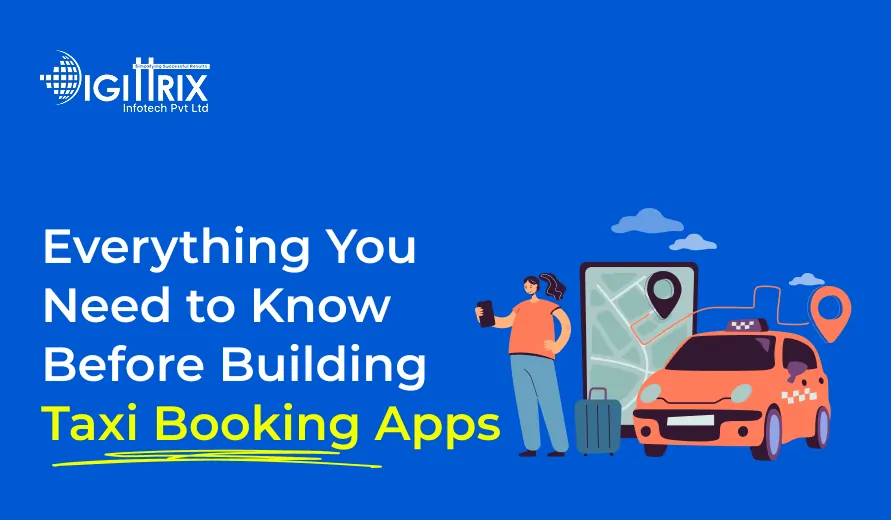Taxi booking apps are expanding quickly, providing convenience, affordability, and innovative features. Companies around the world are investing in app development to keep up with increasing user expectations effectively.
Highlights
An enthusiastic developer and skilled business management expert with over a decade of experience in the field

In recent years, the taxi service industry has changed significantly because of the growth of mobile technology. Customers no longer depend only on calling a cab; instead, they prefer apps that let them book rides quickly and easily. If you're thinking about creating a taxi booking app, there are several important factors to remember. This guide will cover everything from the planning phase to technical requirements and monetization strategies for taxi booking apps.
Thinking of starting a taxi service? Check out Digittrix’s comprehensive guide to launch your own taxi booking business!
Taxi booking app development involves creating a mobile application that enables users to book taxis using their smartphones easily. A typical taxi app connects riders with drivers and manages bookings, payments, and navigation efficiently. A well-designed taxi booking app enhances customer satisfaction and helps taxi companies grow their business services.
Before starting taxi app development, it's essential to understand the type of app you want to build. Different categories include on-demand taxi booking apps, ride-sharing apps, and carpooling apps. Each one has distinct features tailored to specific business needs. For instance, on-demand taxi booking apps allow users to book taxis instantly, while carpooling apps focus on sharing rides among multiple users.
A successful taxi booking app must include several key features for both passengers and drivers. These features ensure smooth operations and a positive user experience.
Users should be able to create accounts using their email, phone number, or social media profiles. Driver accounts also require registration, including document verification, driver’s licenses, and vehicle information details.
Passengers should be able to quickly book rides or schedule them for later. The booking system should be simple, with clear input fields for pickup and drop-off locations.
GPS integration is crucial for real-time location tracking. Passengers can see the driver approaching, and drivers can find the shortest route with integrated maps. GPS tracking also allows the app to calculate fares accurately.
A taxi booking app development must provide multiple payment options, such as credit/debit cards, digital wallets, and cash. Secure payment integration is crucial for earning user trust.
After each ride, both passengers and drivers should be able to rate each other. Ratings help uphold service quality and promote accountability among drivers.
Push notifications, SMS alerts, or email updates keep users informed about ride status, promotions, and important news. Notifications improve communication between drivers and passengers.
The admin panel acts as a central dashboard for managing the app. It enables the admin to track rides, monitor driver performance, process payments, and address user issues.
Choosing the right technology stack is crucial for developing a taxi app. The tech stack impacts the app's performance, security, and overall functionality scalability.
For Android apps, Java or Kotlin are commonly used. For iOS apps, Swift or Objective-C is the standard choice. These languages ensure a smooth and responsive user experience interface.
Node.js, Python, or PHP can be used for server-side operations. The backend manages ride requests, payment processing, and data management storage.
MySQL, PostgreSQL, or MongoDB are commonly used to store user data and ride information data.
Google Maps API, payment gateway APIs, and SMS APIs are essential for location services, payments, and communication notifications.
To build a successful taxi app, you may need to hire experienced developers. An Android app developer focuses on building the Android version, while an iOS developer handles the iOS version. A skilled taxi app development company can manage both platforms and ensure smooth operation and integration.
Developing a taxi booking app involves several stages, from planning to launch and ongoing maintenance. Below is a step-by-step process.
Understanding the target audience is the first step. Research competitors and analyze user preferences to identify the essential features your app needs. Consider local market demand and potential challenges in your area.
Based on research, list essential features for passengers, drivers, and admins. Decide whether to develop an on-demand taxi booking app or a carpooling app. Developing a carpooling app includes extra features like ride matching and sharing preferences.
You can create a native app for each platform or a cross-platform app that runs on both Android and iOS. Native apps usually deliver better performance, while cross-platform development saves time and effort cost.
The app design should be simple, intuitive, and visually appealing. A good UI guarantees easy navigation and increases user satisfaction. Focus on booking screens, maps, driver details, and payment options.
The backend handles all business logic, user management, ride requests, payments, and notifications. A strong backend ensures reliability and a smooth app experience performance.
Testing is essential for finding bugs and improving app performance. Conduct functional testing, usability testing, and security testing before launching the app. A high-quality taxi app reduces negative reviews and customer complaints.
After thorough testing, the app can be launched on the Google Play Store and Apple App Store. Regular updates and maintenance are essential to fix bugs, introduce new features, and ensure compatibility with the latest platforms and devices.
Taxi booking apps earn revenue through different methods. Understanding these strategies helps you develop your business model effectively.
A common method is to take a percentage of the fare from each ride. This guarantees a steady income based on app usage.
Some apps charge a small service fee for each ride booked. This fee can vary based on location or time of day.
Subscription plans offer loyal users discounts, priority rides, or additional perks. This builds user loyalty and promotes repeat business income.
Taxi apps with a large user base can display ads, sponsored content, or promotions from local businesses to generate additional revenue.
While developing a taxi booking app is promising, some challenges must be addressed and considered.
Hiring a skilled taxi app development company can help overcome these challenges, as they bring experience and expertise in delivering robust solutions.
The success of your taxi booking app depends on the skill of your development team. An experienced Android app developer can create efficient Android versions, while an iOS developer ensures smooth performance on Apple devices. Additionally, a taxi app development company can offer comprehensive solutions, from UI/UX design to backend development and post-launch support. When hiring developers, review their portfolio, previous projects, and technical skills to ensure they can deliver a high-quality product.
Quality assurance is a crucial part of developing a taxi booking app. A thoroughly tested app provides a better user experience and decreases the likelihood of crashes or errors. Testing should include:
A taxi app development company usually provides dedicated testing teams to guarantee the app meets industry standards.
Once your app is developed and tested, the next step is launching it successfully. Marketing strategies can include:
Continuous marketing efforts after launch help sustain user engagement and attract new users.
After the launch, continuous maintenance is crucial for the success of a taxi app including:
A reliable taxi app development company can provide ongoing support to keep the app running smoothly and competitive.
Building a taxi app? Avoid common pitfalls by reading Digittrix’s expert guide and ensure a smoother development process!
Building a taxi booking app can be a profitable venture if done correctly. Understanding the app development process, key features, technology stack, and monetization strategies is crucial before starting. Choosing the right developers, whether individual Android and iOS app developers or a taxi app development company, ensures the app meets user expectations. Focusing on testing, maintenance, and marketing will help your app succeed in a competitive market.
By carefully planning and executing taxi app development, businesses can provide convenient and secure transportation services, attract a loyal user base, and maintain steady revenue. Whether you're building an on-demand taxi booking app or a carpooling service, attention to detail and user experience are crucial for long-term success.
In today’s fast-moving world, the need for convenient, accessible, and dependable transportation options continues to increase. As taxi booking services become more popular, both new and established companies are vying for users’ attention. To succeed in this competitive landscape, it’s essential to develop a taxi booking app that meets user expectations while avoiding common pitfalls that can limit growth.
At Digittrix, we specialize in developing taxi booking apps, offering expert solutions for startups and businesses aiming to enter this industry. With over 14 years of experience in mobile app development, we assist companies in creating apps that are secure, scalable, and user-friendly.
If you’re ready to turn your taxi booking app idea into reality and attract potential investors, schedule a consultation with our expert technical managers. Contact us at +91 8727000867 or email digittrix@gmail.com for all inquiries and take the first step toward building a successful taxi booking platform app.

Do you need help in Mobile App development?




Join over 1500+ businesses we've already helped!
Common features are trip scheduling, GPS tracking, multiple payment methods, fare calculation, driver verification, and customer feedback options.
It depends on your audience. Some businesses prefer building apps for Android and iOS separately, while others choose cross-platform development.
Challenges include handling strong competition, meeting local transport rules, ensuring smooth payment processing, and maintaining enough drivers during peak hours.

©2025Digittrix Infotech Private Limited , All rights reserved.